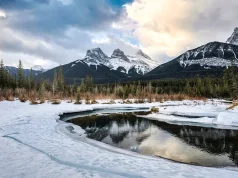
New research from walking holiday experts Inghams Walking reveals the official Dark Sky parks around the world that are off the beaten track, but highly recommended by visitors.
Global search data, Google reviews, and AllTrails scores for over 122 Dark Sky parks were analysed, with the final rankings reflecting which parks around the world provide the best experience for stargazers.
Those with low Google searches but high visitor review scores were ranked in the new index to reveal the best starry night experiences around the world.
Top 15 Dark Sky Parks for the Best Starry Night Experience
| Rank | Dark Sky (Park) | Country | Google Review Score | AllTrails Score | Average Monthly Google Searches | Weighted Quality Score |
| 1 | Waterton-Glacier International Peace Park | Canada | 4.9 | 4.8 | 1,300 | 94% |
| 2 | Yeongyang Firefly Eco Park | South Korea | 4.7 | 5 | 90 | 94% |
| =3 | Ainos National Park | Greece | 4.9 | 4.7 | 480 | 92% |
| =3 | Mayland Earth to Sky Park & Bare Dark Sky Observatory | USA | 4.9 | 4.7 | 480 | 92% |
| 5 | UbarU Camp and Retreat Center | USA | 4.9 | 4.6 | 50 | 90% |
| 6 | Pickett CCC Memorial State Park & Pogue Creek Canyon State Natural Area | USA | 4.8 | 4.7 | 1,300 | 90% |
| 7 | Hehuan Mountain | Taiwan | 5 | 4.5 | 1,000 | 90% |
| 8 | De Borschplaat | Netherlands | 4.7 | 4.7 | 10 | 88% |
| 9 | Elan Valley Estate | Wales | 4.7 | 4.7 | 50 | 88% |
| 10 | Naturpark Attersee-Traunsee | Austria | 4.8 | 4.6 | 390 | 88% |
| 11 | OM Dark Sky Park & Observatory | Northern Ireland | 4.9 | 4.5 | 390 | 88% |
| 12 | North Fork Park | USA | 4.8 | 4.5 | 260 | 86% |
| 13 | Flagstaff Area National Monuments | USA | 4.5 | 4.8 | 110 | 86% |
| 14 | Pisgah Astronomical Research Institute | USA | 4.5 | 4.7 | 30 | 84% |
| 15 | Oxford Forest Conservation Area | New Zealand | 4.6 | 4.5 | 10 | 82% |
Topping the list of the top 20 starry night experiences is Canada’s Waterton-Glacier International Peace Park, which has an incredibly high review score of 4.9 on Google and 4.8 on AllTrails, whilst still flying under the radar with less than 1,500 Google searches a month.
The majority of official Dark Sky parks are located in the USA, and they are well represented within the global index rankings, with North Carolina’s Mayland Earth to Sky Park in joint third place and the UBarU Camp and Retreat Center in Texas ranking fifth.
However, Europe’s stunning Dark Sky parks are also highlighted in the research, with the Elan Valley Estate in Wales coming out as the ninth best stargazing experience in the world, Greece’s Ainos National Park on Kefalonia ranking third, and De Borshplaat in the Netherlands ranking eighth.
World’s top ten stargazing experiences
- Waterton-Glacier International Peace Park, Canada
With its snow-capped mountains, glaciers, and stunning rugged rock formations, Waterton-Glacier International Peace Park is a beautiful place to explore during daylight hours, as well as when the sun goes down.
It’s been granted Dark Sky status thanks to the prioritization of resources that protect and conserve its dark skies, and according to UNESCO, it provides ‘outstanding scenery’ as well as being ‘exceptionally rich in plant and mammal species’. Waterton-Glacier International Peace Park tops the index of Best Starry Night Experiences with an impressive 4.9 stars on Google Business, and an AllTrails score of 4.8.
Coupled with the fact that it remains fairly unknown in terms of Google search volumes, this Dark Sky park offers a peaceful and unforgettable stargazing adventure.
- Yeongyang Firefly Eco Park, South Korea
Yeongyang Firefly Eco Park is a remote yet accessible site in the valley of the Wangpi River, and its dark skies provide visitors with an incredible opportunity to view both the unique firefly displays across the Suha Bridge, as well as providing the perfect conditions to gaze at the stars above. Yeongyang Firefly Eco Park was the first protected Dark Sky site in Asia, and it’s sure to build in popularity with stargazers thanks to its magical and heady mix of nighttime skies showcasing the Milky Way at its best, alongside the bioluminescent display of the fireflies that it protects.
- Aenos National Park, Kefalonia, Greece
Ainos is the highest mountain on this Greek island, helping stargazers feel like they are within touching distance of the celestial wonders in the nighttime sky above. The park has a super high Google review score of 4.9, and is just as enchanting in daylight hours, with fir tree forests and roaming horses all adding to the mythological ambience of this Grecian paradise.
- Mayland Earth to Sky Park & Bare Dark Sky Observatory, NC, USA
The Bare Dark Sky Observatory in North Carolina welcomes amateur astronomers to use their own telescopes within the flat areas of the park, as well as offering the public the use of the Observatory’s equipment, including a custom-built Newtonian telescope. With one of the highest Google review scores (4.9) but fewer than 500 Google searches a month, the Mayland Earth to Sky Park & Bare Dark Sky Observatory site shines as a hidden gem in the stargazing world.
- UbarU Camp and Retreat Center, TX, USA
Located in Gillespie County, Texas, the UbarU Camp and Retreat Center offers a spiritual and educational way to connect with the nature and history of this area. Previously run by a Quaker community, the park is now operated by the Unitarian Universalist Friends Retreat Foundation, who is committed to protecting the nature and wildlife that thrive under dark skies.
- Pickett CCC Memorial State Park & Pogue Creek Canyon State Natural Area, TN, USA
Pickett CCC Memorial State Park is found in the upper Cumberland Mountains of northern Tennessee and is going to great lengths to celebrate and make people aware of the importance of protected dark skies across the United States.
This protected site offers a New Year’s Eve hike (what better way to see in the new year than by soaking up the stars above in a beautiful outdoor setting!) as well as a Junior Ranger Camp for the local community, and a regular programme of stargazing events during the summer months. It’s highly regarded by those who have visited, with a score of 4.8 and 4.7 on Google Business and AllTrails, respectively, and with just 1,300 online searches a month, it’s one of the lesser-known Dark Sky locations around the world.
- Hehuan Mountain, Taiwan
With altitudes to rival the Alps or the Rockies, the alpine scenery of Hehuan Mountain is attracting more and more walkers to Taiwan. The snow-capped mountains here are a rare occurrence in such a subtropical climate, and visitors who have explored the forest firs and green slopes of Hehuan and seen the bright stars fill up the sky above want to revisit the area again and again.
- De Borschplaat, Netherlands
Found on the island of Terschelling, De Borschplaat is recognized as a Natura 200 nature reserve. With its grassy dunes, marshlands, and pale sandy beaches, the area is popular with walkers and wildlife lovers as well as stargazers.
- Elan Valley Estate, Wales, UK
Nestled in the heart of the Cambrian Mountains, Elan Valley’s Trust has gone to great care to protect the nighttime environment and raise awareness about the fragility of dark skies. Before settling in for a night of stargazing, visitors can explore the rolling hills and incredible dams and bridges found here.
- Naturpark Attersee-Traunsee, Austria
The dark skies in this part of the Alps are the darkest in Europe and provide spectacular conditions for stargazing all year round. The surrounding hills also provide year-round wonder, with fruit trees blossoming in the spring, bright wild flower meadows in the summer, and the changing colors of the forests in the autumn.
How to stargaze in Dark Sky parks responsibly
The organisations and parks that are protecting and conserving our dark skies are doing an incredible job at preserving the natural wonders of our planet.
However, to keep our natural landscapes as unspoilt as possible, Inghams offers a few things we can all remember to do whilst exploring:
- Leave No Trace: The one rule to remember is to try and leave no trace when visiting natural trails or environments – this means taking everything you bring in back out with you, including food, wrappers, bottles, and other waste.
- Stay On Designated Trails: To minimise soil erosion and damage to the environment surrounding trails, ensure you stick to established trails and paths – and avoid creating shortcuts or new trails.
- Don’t Take Souvenirs From Your Walk: In order to maintain environments and ecosystems as much as possible, never take souvenirs such as plants, flowers, berries, shells, rocks, or animal parts. If you believe you’ve come across something of significance, leave it where you found it and report to the local authorities.





